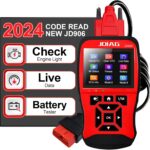Navigating the complexities of modern vehicle diagnostics can be daunting, especially when that pesky check engine light illuminates on your dashboard. For American car owners, finding a dependable and budget-friendly OBD-II scanner is a top priority. The U281 scanner frequently emerges in discussions as an affordable entry-level tool. But does the U281 scanner truly deliver on its promises, particularly for diagnosing and maintaining American-made vehicles? Let’s delve into the capabilities of the U281, explore its limitations, and discuss superior alternatives available in the market today.
The U281 scanner is often touted as a compact and inexpensive solution for reading and clearing basic OBD-II fault codes. Its appeal lies in its simplicity and low price point, making it an attractive option for car owners looking to avoid costly trips to the mechanic for minor issues. For European car brands, and specifically Volkswagen as seen in online discussions, users have explored the U281 for tasks like resetting airbag warning lights. However, when it comes to American cars, the question of compatibility and effectiveness becomes crucial.
While the U281 claims to be compatible with OBD-II compliant vehicles, which includes most cars sold in the US from 1996 onwards, user experiences suggest a more nuanced reality. The original online discussion highlights a user’s attempt to use a U281 scanner on a Volkswagen to reset an airbag light – a scenario that ended in frustration and the U281 ultimately failing to work, even with the original factory stereo installed. This real-world example underscores a critical point: scanner compatibility isn’t always guaranteed, even within the OBD-II standard.
A close-up view of a U281 OBD2 scanner, a budget-friendly tool often considered for basic car diagnostics.
For American car brands like Ford, Chevrolet, Chrysler, and others, the diagnostic landscape can be more intricate. While a basic scanner like the U281 might read generic OBD-II codes related to the engine and emissions, it often falls short when it comes to accessing more advanced systems or manufacturer-specific codes. American cars, with their unique engineering and electronic architectures, may require scanners with enhanced capabilities to accurately diagnose issues beyond the basic powertrain.
Considering the limitations of the U281, especially for potentially complex American vehicles, what are the more reliable alternatives? The online discussion itself points towards better solutions. Users in the forum thread recommended tools like OBD Eleven and Carista dongle, particularly for Volkswagen group vehicles. While OBD Eleven is highly regarded within the VW/Audi community for its in-depth diagnostics and customization options, its applicability to American cars may be limited. Carista, on the other hand, offers broader vehicle compatibility and user-friendly app-based interface.
Another tool that emerged as a successful solution in the original discussion was the Ancel VD500. Although initially seeking a cheap fix with the U281, the user in the forum thread eventually opted for the Ancel VD500 and successfully reset their airbag light. This suggests that investing slightly more in a scanner like the Ancel VD500 can yield significantly better results and broader vehicle compatibility, potentially including American car models.
When choosing an OBD-II scanner for your American car, consider these factors beyond just the initial price:
- Vehicle Compatibility: Verify if the scanner explicitly supports American car brands and models, especially if you own a less common or older vehicle.
- Diagnostic Capabilities: Determine if you need basic code reading and clearing, or more advanced functions like live data streaming, component testing, or access to manufacturer-specific codes.
- Ease of Use: Consider the scanner’s interface, screen size, and overall user-friendliness, especially if you are not a seasoned mechanic.
- Updateability: Check if the scanner software can be updated to support newer vehicles and diagnostic protocols.
In conclusion, while the U281 scanner might seem like an enticingly cheap option for basic car diagnostics, its limitations, especially concerning American cars and more complex issues, should be carefully considered. The experiences shared in the original discussion highlight the potential frustrations of relying on a basic scanner that may not be fully compatible or capable. For American car owners seeking a more dependable and versatile diagnostic tool, exploring alternatives like Ancel VD500, Carista, or other reputable OBD-II scanners with broader vehicle coverage and advanced features is highly recommended. Investing in a slightly more capable scanner can save you time, money, and frustration in the long run, ensuring you can effectively diagnose and maintain your American vehicle.

